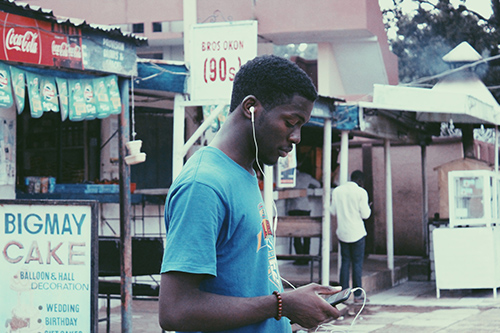A social scientist examines the role of technology in our lives

Photo by Muhammadtaha Ibrahim on Unsplash
Author: Jonathan Rotner
Terkadang dalam hidup, perlu mengubah kecepatan dan keadaan pikiran, translates from Indonesian to sometimes in life, you need to change your speed and state of mind. This line appears under Dr. Laura Steckman’s MITRE email signature and was inspired by her time doing field work in Indonesia. Her international experiences helped her to think about how personal identity changes through interactions with different technological forces, and how different cultures adopt technology in ways consistent with local norms and behaviors.
“Each culture has its own rituals around technology. What I do is examine how people and technology each shape the other.” She points to my phone, sitting on the table, and gives an example. In the West, we started with land lines, then moved to dial-up, mobile phones, and finally the smartphone. But in Africa, laying landlines or internet cables across the enormous distances of the continent is quite costly; putting up cell-towers is much more appealing. Going straight to mobile led to some interesting developments that go beyond the revelations that accompany information access. African ingenuity offered outcomes to a different set of problems that would not have been developed elsewhere, but are now used elsewhere, like building smaller and cheaper or solar-powered boxes for internet access in remote villages. Laura is fascinated by what comes next: even though programming languages are the same, how people are taught, how they think, and what their needs are all differ, so how does their environment shape what villagers in rural Africa will create? Laura summarizes, “Language and culture change how we use technology and, inversely, technology changes norms.”
As one of MITRE’s few Sociotechnical Scientists, Laura applies her research to our sponsors’ problems. “Sociotechnical Scientists combine the social and technical realms,” she explains. “We at MITRE do high-quality, technical solutions. I want to infuse the human and social components into our work. The power comes from bringing humans and technology together in order to build outcomes that reflect and address the complexity of technology integration within societies.”
Laura’s process starts by evaluating the current direction of technology and human behavior. “We have to understand our reality, positive or negative, so we can plan accordingly.” Appreciating where we’re at could be the difference between a success story and scratching your head wondering why a good idea didn’t take. For example, got a project on sentiment analysis of social media output from Asia? Sociotechnical Scientists may point you to a Japanese proverb: “The nail that sticks out shall be hammered down,” which illustrates how the drive to be well-liked shapes what is publicly posted. Working to develop a strategic response to China’s approach of releasing AI algorithms into the wild? Sociotechnical Scientists will analyze different Chinese drivers (e.g., creating international dependence on Chinese code, benefiting from seeing unanticipated ways of adopting the tech, establishing norms and standards by influencing early adopters) and the potential outcomes of different American responses. Figuring out how to apply machine learning to military battlefield logistics? A Sociotechnical Scientist will help map out conflicting outcomes by conducting studies to identify behavioral factors to minimize down-time or prioritize safety, develop relevant measures of performance, and uncover behavioral workarounds or resistances that operators may have.
By the way, MITRE scientists are already thinking about all of these questions and more.
Laura’s newest email signature comes from the eighteenth-century writer Johann Wolfgang von Goethe: Few people have the imagination for reality. “We need to become the people who can imagine reality,” says Laura. Laura wants to recruit more to her cause through engaging visuals and creative storytelling, and it seems her message is gaining traction among sponsors. They are reaching out to her to ask more questions, they are integrating solutions that are grounded in research and evidence, and just this month a new Social Science and AI Roundtable has been stood up by sponsors. If anyone wants it, I can think of a guiding mantra for the Roundtable: it’s only once we appreciate how our norms and technology interact that we can change our speed and state of mind.
Jonathan Rotner is a human-centered technologist who helps program managers, algorithm developers, and operators appreciate technology’s impact on human behavior. He works to increase communication and trust in an automated process.
© 2019 The MITRE Corporation. All rights reserved. Approved for public release. Distribution unlimited. Case number 19-1848
MITRE’s mission-driven team is dedicated to solving problems for a safer world. Learn more about MITRE.
See also:
Interview with Tammy Freeman on Redefining Innovation
Interview with Jesse Buonanno on Blockchain
Interview with Dr. Michael Balazs on Generation AI Nexus
Is This a Wolf? Understanding Bias in Machine Learning
Designing a Bridge Between Theory and Practice
Consequences and Tradeoffs—Dependability in Artificial Intelligence and Autonomy
The World as It Will Be: Workforce Development Within and Beyond MITRE
Catch You Later: Recap of the Generation AI Cyber Challenge
Phish, Flags, and Lesson Plans: Upcoming Hackathon for Generation AI Nexus
Technical Challenges in Data Science
Defining, Applying, and Coordinating Data Science at MITRE
Rising to the Challenge: Countering Unauthorized Unmanned Aircraft Systems
Mistakes and Transcendent Paradoxes: Dr. Peter Senge Talks on Cultivating Learning Organizations
